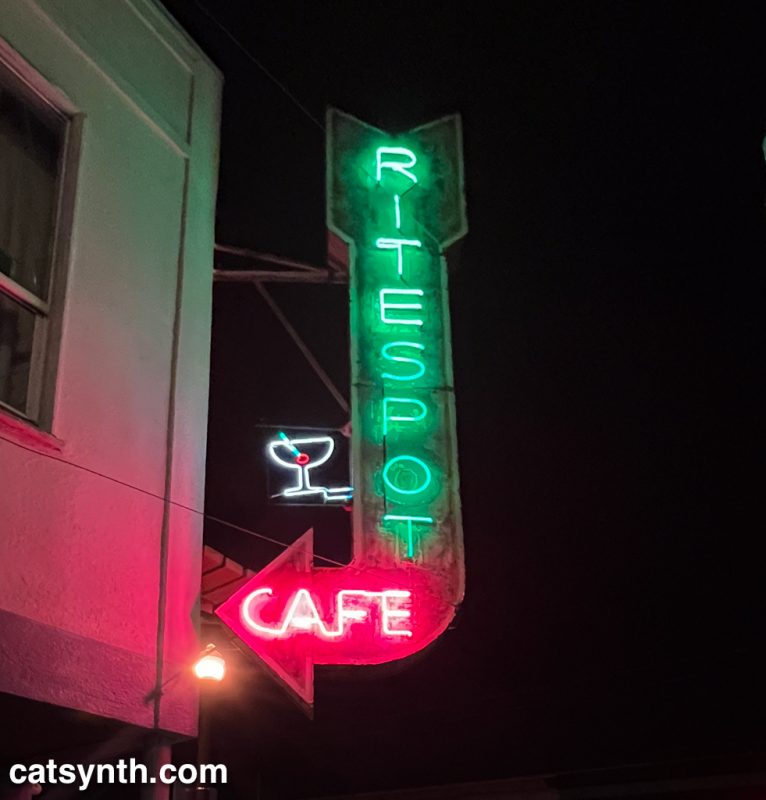
The Rite Spot Cafe in San Francisco is a great little venue in the Mission District for food, drink, and live music. We saw our friends in Past Present Future play there a couple of weekends ago and featured them in a recent CatSynth TV episode.

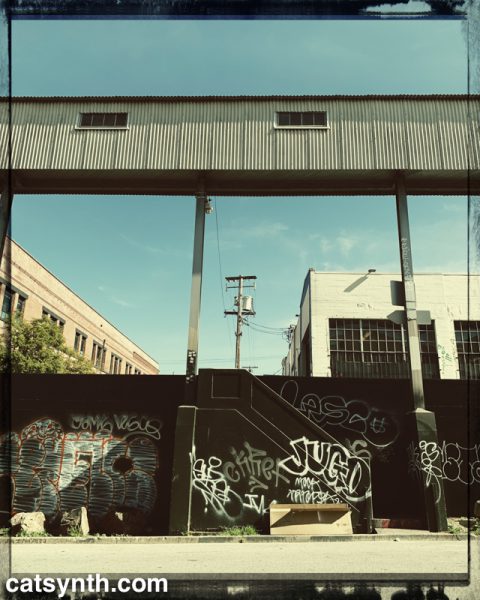
Hipstamatic shot near the end of Florida Street in San Francisco, very close to the location of an earlier photo featured in February.
After a couple of months away from live performance, I found myself playing two shows in one weekend, both in the Mission District of San Francisco. They were an exercise in contrasts artistically, but both were delightful in different ways.
Word Performances is a “variety show” of poets, musicians, and dancers produced by Cybele Zufolo Siegel and Todd Siegel. The latest incarnation took place at the Lost Church, a favorite venue of mine for its cozy theater and visual vibe reminiscent of David Lynch.

Like any good variety show, it features a staple of regular players that includes both Cybele and Todd, but also Pitta of the Mind as a recurring act. There were of course new participants as well, especially among the poets. You can see a bit of everyone in our video from the evening.
As is clear from the short excerpts, there was a diversity of styles and subject-matter. There were the spartan settings of the readings by Rose Heredia, Jon Sindell, Crystal Jo Reiss, and William Taylor, Jr. Todd and Cybele also gave readings, but with violin accompaniment provided by Hannah Glass. And flamenco Dancer Damian Alvarez stole the show with his tightly choreographed dance to the music of James Brown.
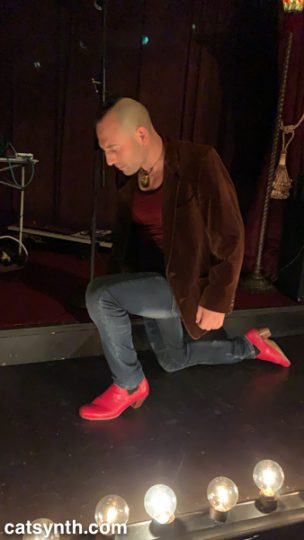
For Pitta of the Mind – myself and poet Maw Shein Win – we performed a brand new set with new poems, and a new color theme of green. The instruments were the same as for our previous performances, combining the Nord Stage, Prophet 12, and modular synthesizers. The consistency in structure and instrumentation helps in our ability to quickly come up with a new set.

Other than my psychedelic lights not working as expected, it was a solid set overall, and we are always happy to be part of the Word Performances shows.

If Word Performances provided a diversity of styles and media, the show later that weekend was very focused on invented instruments, unusual sounds, and the birthday of our friend David Michalak. You can see a bit of everyone in our CatSynth TV video (with David giving the valedictory tag).
This was the first time I performed as a duo with Scott Looney, but I was quite happy with the results. We are both skilled improvisers and were able to blend our sounds and ideas together seamlessly, with my performing on an Arturia MiniBrute 2 and Scott on a custom string instrument with various preparations.
Our set as well as the one that followed us featuring Tom Nunn, David Michalak, and Aurora Josephson had a similar texture: a lot of wisps, scrapes, and staccato elements. It was interesting to see how much musically David could get out of a flat piece of cardboard! The opening set with Tom Nunn on skatchbox and Ron Heglin on voice also had a very pointed and sparse texture.
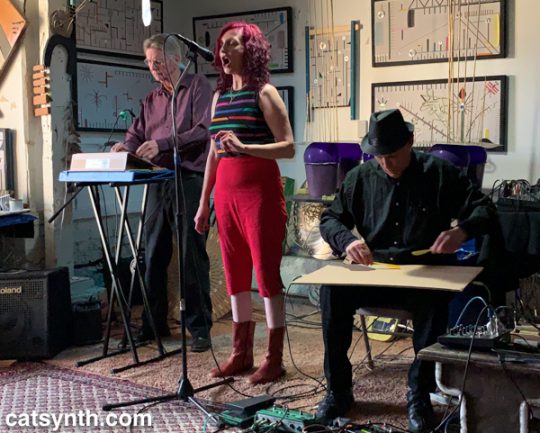
The final set featuring Ghost in the House had a softer, longer, and more liquidy quality. This time David Michalak was performing with a processed harmonica and lap steel guitar, with long tones matched by Polly Moller Springhorn on bass flute and Cindy Webster on musical saw – and this was no ordinary musical saw, it seemed built specifically for music.
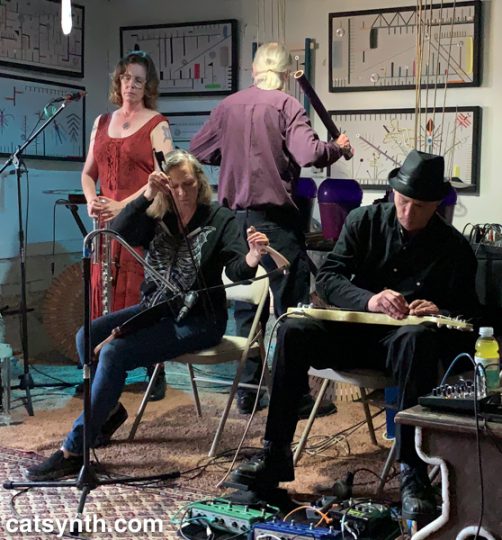
Overall, it was a fun show, and of high quality musically. It’s a shame more people weren’t able to hear it live – it was a private event – but the video captures much of the experience in a compact form.
As we busily prepare for the next Vacuum Tree Head show this coming Tuesday, I find myself looking back at my last show with a very different band, Manul Override earlier this month at the Make-Out Room in San Francisco. It was the subject of a recent CatSynth TV episode.
The evening began with an improvised set featuring saxophonist David Pate with keyboardist Steve Cohn.
Then it was time for Manul Override’s debut show. This was a new group I put together with my friend and collaborator Serena Toxicat on voice and former Surplus-1980 bandmate Melne on guitar.

We had a lot of fun on stage, and the energy spread to the audience, with dancing and meowing all around (all of our tunes had at least some connection to cats). I was particularly happy with the opening incantation, which featured a French rendition of Serena’s ode to the goddess Bast, and our 1980s-pop-style tune “Goodnigobbles”, which also featured Serena seductively delivering lyrics and spoken words in French. Melne had a chance to show her versatility throughout the set, including our extended funky jam in the middle of the set. As with all new musical projects, this is a work in progress, figuring out what works for us and what doesn’t, and how to make each show better than the previous one. But it was also fun visually, with our fashion statements, cat ears, and Melne’s lighting.
The final set featured Ornettology, a project led by guitarist and composer Myles Boisen. As the name suggests, the group is inspired by the music of Ornette
The band delivered a truly dynamic performance that featured some of Ornette Coleman’s more familiar tunes, including “Ramblin'” and “Mob Job” There were some great solos from each of the members of the group as well. You can hear some of Philip Greenlief and Myles Boisen soloing in our video.
The last few shows I have played at the Make-Out room always have a great audience – full houses that seem to appreciate having live music, whether they came to hear the specific artists or just happened to drop by. A few in the latter category seemed to quite enjoy our Manul-Override set, signing Serena’s leg cast (she had an unfortunate accident a couple of weeks before the show) and taking selfies with us. It was a fun night of music all aroundl.
Greetings, and L’Shana Tovah! Today we look back to a show from last weekend at The Chapel in San Francisco where two bands interpreted selections from John Zorn’s Masada songbook. It was part of a four-day residency by Zorn at the Chapel in celebration of his 65th Birthday.
“Masada” has morphed and grown as a musical concept since Zorn’s original Ornette-Coleman-inspired group from the 1990s. There have been follow-up projects, notably Electric Masada that we at CatSynth are most familiar with. But it is as much a songbook as a collection of ensembles. The “Masada songbook” contains hundreds of short compositions, sometimes just fragments, scales, or concepts. Originally intended to be performed by the ensembles, these compositions can be interpreted by other bands. And on this night, the bands took them in decidedly rock direction.
First up was Cleric. The Philadelphia-based “avant-metal” band currently features Matt Hollenberg on guitar, Nick Shellenberger on keyboards and vocals, Larry Kwartowitz on drums, and Daniel Ephraim Kennedy on bass.
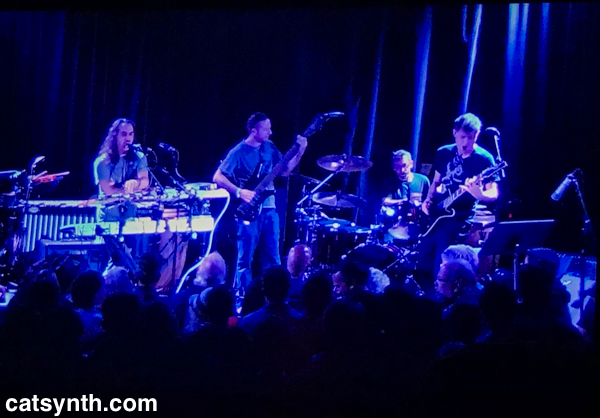
As their background implies, the performance was decidedly metal, a full-on triple-forte projection with growling vocals and fast runs punctuated by heavy drones. Nonetheless, it was top-notch musicianship and an adventurous choice of music. Within the mix, I found myself mostly focused on Shellenberger’s vocals and keyboards, though Kennedy’s six-string bass took center stage visually, and Hollenberg’s guitar performance added a solidifying aspect to the music. It was a solid set, and certainly an interpretation of the Masada songbook we have never heard before (and may never hear again).
Next up was Secret Chiefs 3, who brought a decidedly different sound and presentation to the stage.

Led by guitarist and composer Trey Spruance (formerly of Mr. Bungle and Faith No More) and heavily featuring Eyvind Kang on violin, the group weaved together jazz, rock, folk, klezmer, and Middle Eastern influences into their eclectic set. Rounding out the group on this night were Jason Schimmel on guitar, Matt Lebofsky on keyboards, Shanir Blumenkranz on bass, Ches Smith on percussion, and Kenny Grohowski on drums.
It was an inspired and highly dynamic performance from these hometown favorites, and the band seemed a good match for the Masada songbook. There is an explicit thread of mysticism and the esoteric in both Zorn’s music and the work of SC3, so this is not surprising. I even recognized a couple of songs from Electric Masada recordings. The orchestration was brilliant and clever, bringing out each of the musicians as well as the Jewish influences of the songs. There were contrapuntal moments where the musicians played different lines and rhythms but coming together for short emphatic choruses with syncopated lines. It was crisp, tight, but also fun. And one could sense that the audience – a packed crowd on both levels of the Chapel, was having a great time along with them. The set was also the perfect length, keeping up the energy without petering out or overstating their welcome, leading to a single climax note that ended the music and cued Zorn and the musicians from Cleric back to the stage for a final group bow.
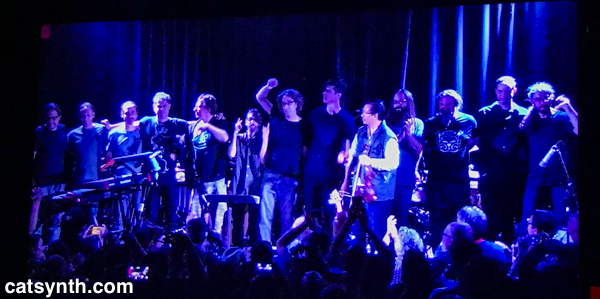
Overall, a fine night of music. As with many multi-day festivals, I regret not being there for the other nights, but glad I was able to make it to the one that I did. September is always the busiest month for music (and art) in San Francisco, and we will have much more to experience and share in the coming weeks.
The final night of the Outsound New Music Summit featured a performance by Karen Borca, returning to the Bay Area for the first time in two decades. For those not familiar with Borca, she is one of the few bassoonists in avant-garde jazz and free jazz; and she had a long and illustrious career playing with many of the greats in the field, including Cecil Taylor and Jimmy Lyons. On this night, she was joined by two figures in the local jazz and experimental-music scene, Lisa Mezzacappa on bass and Donald Robinson on drums.

[ Karen Borca Trio (Karen Borca, Lisa Mezzacappa, Donald Robinson). Photo: peterbkaars.com]
Bassoon is a hard instrument to play in any genre, let alone jazz. But Borca made it sound effortless. There were sections that featured the instrument’s well-known lower registers, but also higher melodic lines and runs more often associated with saxophones. Interestingly, Borca discussed how she started on saxophone in school and was shredding the instrument until she was advised to try the bassoon, as it was both more challenging and more likely to make her stand out for scholarships and such. And this turned out to be the right decision. Musically, things unfolded with sparse lines and harmonies and the three performers bounced off one another. The best moments were when the notes from bassoon, bass and drum all seemed to form a single line.

[ Karen Borca. Photo: peterbkaars.com]
It was a shorter set, but very well received with audience clamoring for more afterwards. But I can understand that the music took a lot of energy. But it was a great experience, and Karen Borca has now taken her place alongside Wendy Carlos, Pauline Oliveros, and all the other women in music that I want to be when I finally grow up.
The Karen Borca trio was preceded by Positive Knowledge, a project of Oluyemi Thomas (bass clarinet and other instruments) and Ijeoma Thomas (voice). They were joined by Hamir Atwal on drums.

[Positive Knowledge. Clockwise from left: Oluyemi Thomas, Hamir Atwal, Ijeoma Thomas.]
I have heard Positive Knowledge before, and know how their music unfolds. There are sparse, scratchy lines from Oluyemi’s bass clarinet and other wind instruments, including a shawm (or similar instrument), interspersed with Ijeoma’s vocals, which include passages of spoken word as well as more extended sounds. The music is at times quite percussive, but also melodic and energetic. There was an exuberance and joy in the sound, even in the moments that seemed to be melancholy. And Atwal’s drums added a foundational underpinning the sustained the set.
So this concludes our coverage of the 2017 Outsound Music Summit. It was the longest we have covered, with five concerts plus Touch the Gear. It can be a bit of overload, so much music and fellowship in a week, but worth the effort. We look forward to next year, and the inspiration for all the musical adventures between now and then.
Each night of the Outsound New Music Summit is different, but some more different than others. Such was the case with the fourth night of this year’s festival which featured two loud rock-oriented bands.
The tone of the evening was set with the opening sounds from VOCO.

The group features Alex Yeung (of Say Bok Gwai) on guitar, Tim Sullivan on drums, and Josh Martin on bass, with guest Joshua Marshall on saxophone. Think rock power trio meets experimental jazz. The band is at times punk, at times metal, at times experimental, but with serious chops. There were the periods that were Zappa-esque, mixing rock and experimental guitar with saxophone and bass runs. There was the dub-metal onslaught at times, reminiscent of the bands Last Exit, or Blind Idiot God. And there was also softer complex drones and percussive sounds from Yeung on guitar, with an array of interconnected effects pedals.

[Alex Yeung. Photo peterbkaars.com]
These more experimental moments, enhanced with electronics, brought to mind the story about the band’s name coming from Neal Stephenson’s science-fiction writing (discussed during the pre-show Q&A). In contrast, there was a particularly fun moment when drummer Andre Custodio walked up on stage from the audience and sat down at a second drum set. What ensued was an epic double-drum performance that was much funkier than the set as a whole, and also reminiscent of the multiple drum sets we saw a few weeks earlier with King Crimson. This was followed by a final segment that brought the set to a sonically intense close.
It was then time for Surplus 1980 to take the stage.

[Surplus 1980. Photo peterbkaars.com]
I did play with Surplus 1980 as part of the regular lineup from 2012 through 2015. I have seen them several times since then, but I have to say the current lineup and set has taken the band to a new level. The performance is tighter and there is increased variety among the tunes. The set began with two new tunes: “Pigeon Obstacle Course” and “Temporarily Present”. “Pigeon” was a short instrumental with Moe! Staiano and Melne wearing pigeon heads.

“Temporarily Present” was a longer song, about 10 minutes, and quite reminiscent of early New Wave from late 1970s and early 1980s. Indeed, the call-and-response vocals between Moe! and Melne and new bassist HR Nelly reminded me a bit of early B-52s performances. The remaining “newish” song was “Question After Ended Question”, which features members of the band playing tuned bundt pans.
After this, the band continued with some familiar songs. I have to admit, I did feel pretty nostalgic hopping up and down during “Failure of Commitment” as I did when I played with them. The new feature on that tune was Moe! on saz. And Melne has come into her own on staging, providing energy and character enough of the whole band. One often just sees her as a bright pink blur as she dances about the stage.


Guitarist Bill Wolter was solid as always; and Mark Pino was a force of nature on drums, even overcoming a somewhat rebellious kick drum (you can read more about it on his blog.
The third concert of this year’s Outsound New Music Summit was truly a study in contrasts between minimalism and large-ensemble exuberance.
First up was neem, the duo project of Gabby Fluke-Mogul (violin) and Kelley Kipperman (double bass).

[neem (Kelley Kipperman and Gabby Fluke-Mogul). Photo: peterbkaars.com.]
This was minimalism in its truest form, starting with the deliberate silence led by Fluke-Mogul before the first note was intoned. The music unfolded in a similarly sparse manner, with plenty of room to observe the details the sounds from both artists’ extended techniques. Although open and spacious, there was also an intimacy in some sections where the two closely followed one another musically, bouncing sounds from one instrument to the other. Whether intentional or not, one could envision the music unfolding in a natural landscape.
By contrast, Sheldon Brown’s Blood of the Air, was large and exuberant, and featured a ten-piece ensemble. In addition to Brown, the group featured Darren Johnston on trumpet, Lorin Benedict on voice, Andrew Joron on theremin, Dave MacNab and John Finkbeiner on guitars, Dan Zemelman on piano, and Vijay Anderson and Alan Hall on drums.

[Sheldon Brown’s Blood of the Air. Photo: peterbkaars.com.]
The work centered around “speech melodies” created from readings by the Beat-era poet Philip Lamantia. Each piece began with a recording of Lamantia reading his poetry, and one of the musicians (often Brown himself) responding in a melody that matched the prosody of Lamentia’s speech. The melodies served as points of departure with the ensemble responding with rhythmic vamps, countermelodies, and solos. When I wasn’t watching Brown’s solos or drawn into Lorin Benedict’s frenetic scatting, I found myself captivated by Zemelman’s virtuosic piano playing, both comping and solo. It was both musically and technically impressive. But the group functioned together as a unit, even in a setting that featured a lot of improvisation, and remained tight.
It is interesting to note that despite the musical contrast, both groups were very much focused on listening as a central element. For Blood of the Air, it was listening to the melody of the rhythm and poetry, and then to one other to form the tightness and musical phrasing of the ensemble. In neem, it was also listening and responding to one another, but was also “deep listening” to the individual sounds of the instruments, and especially to the spaces between the sounds. Yes, all good music requires disciplined listening, but sometimes it’s good to step back and take note of it.